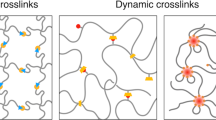Abstract.
While the rheological behavior at the gel point (GP) itself is well known, many questions remain about the approach to the gel point (from either side). For studying this phenomenon, rheological experiments were performed on crosslinked polydimethylsiloxanes (PDMS) and characteristic patterns in the relaxation behavior were abstracted into a phenomenological model for the relaxation time spectrum. The well known power law with slope-n and cutoff at the longest relaxation time λ max governs the relaxation near the gel point. Beyond the gel point, an additional box-like contribution appears in the spectrum. The relaxation exponent n decreases with increasing extent of crosslinking. The longest relaxation time λ max and equilibrium modulus Ge show power-law scaling with the distance from the gel point, |p − pc|. For samples with imbalanced stoichiometric ratios r ≥ 1, the function n (p − pc) is independent of r. Samples with strong crosslinker deficiency (r = 0.5) exhibit a different functional form for n (p − pc) from those with r ≥ 1. The power law relaxation with decreasing n in the terminal zone was found previously for a different crosslinking system. It seems to be a common pattern for partially crosslinked materials from polymeric precursors.
Similar content being viewed by others
Author information
Authors and Affiliations
Additional information
Received: 11 December 1997/Revised version: 18 December 1997/Accepted: 18 December 1997
Rights and permissions
About this article
Cite this article
Mours, M., Winter, H. Relaxation patterns of endlinking polydimethylsiloxane near the gel point. Polymer Bulletin 40, 267–274 (1998). https://doi.org/10.1007/s002890050251
Issue Date:
DOI: https://doi.org/10.1007/s002890050251




